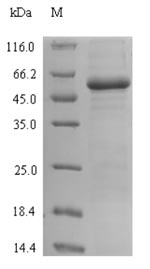This Recombinant E.coli K12 lacI protein was made through genetic engineering. By putting the lacI gene into the genetic material of E.coli cell, the E.coli could be used as factories or producers to make the desired lacI protein for research uses. The expression region of this protein is at 1-360aa. N-terminal 6xHis-SUMO tag was used in the expression process. The purity is 90%+ determined by SDS-PAGE.
The lactose repressor protein (LacI) was among the very first genetic regulatory proteins discovered, and more than 1000 members of the bacterial LacI/GalR family are now identified. LacI has been the prototype for understanding how transcription is controlled using small metabolites to modulate protein association with specific DNA sites. This understanding has been greatly expanded by the study of other LacI/GalR homologues. A LacI, a bacterial TF, is often used to artificially recruit proteins onto eukaryotic genomes. As LacI binds tightly to its recognition site (LacO) in vitro with a Kd about 10 picomolar (pM), it is often assumed that LacI also has high affinity to LacO in vivo. It turns out that the GFP tagging location and the fusion protein stability have a large effect on LacI binding. The common function of the LacI/GalR proteins, which features allosteric regulation of DNA binding to modulate transcription.




